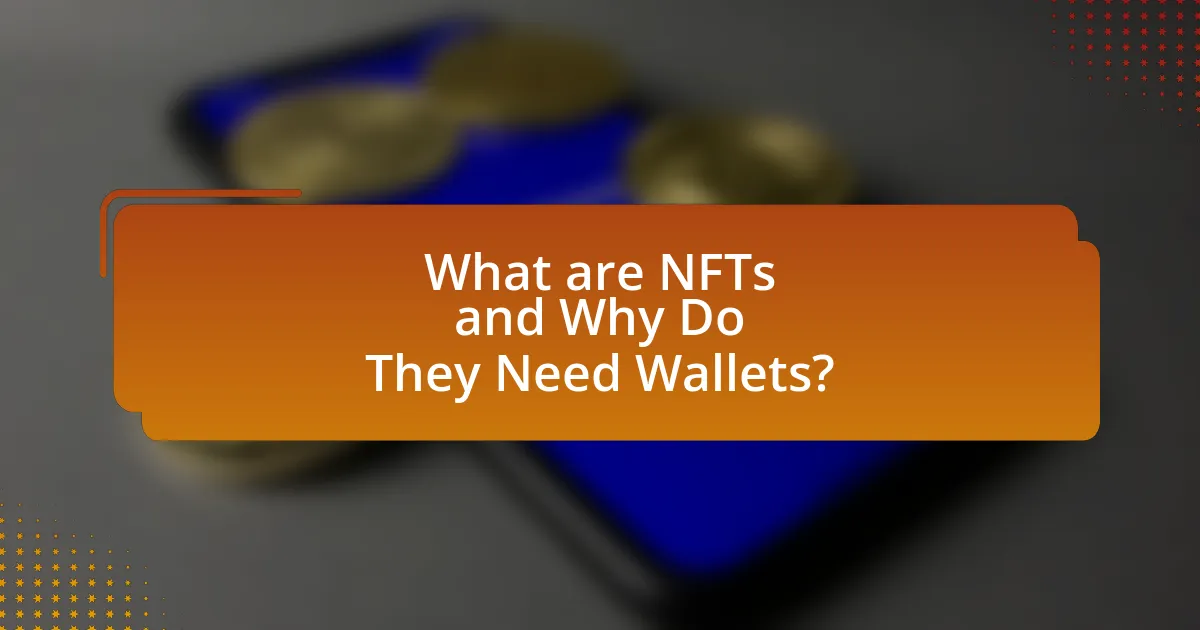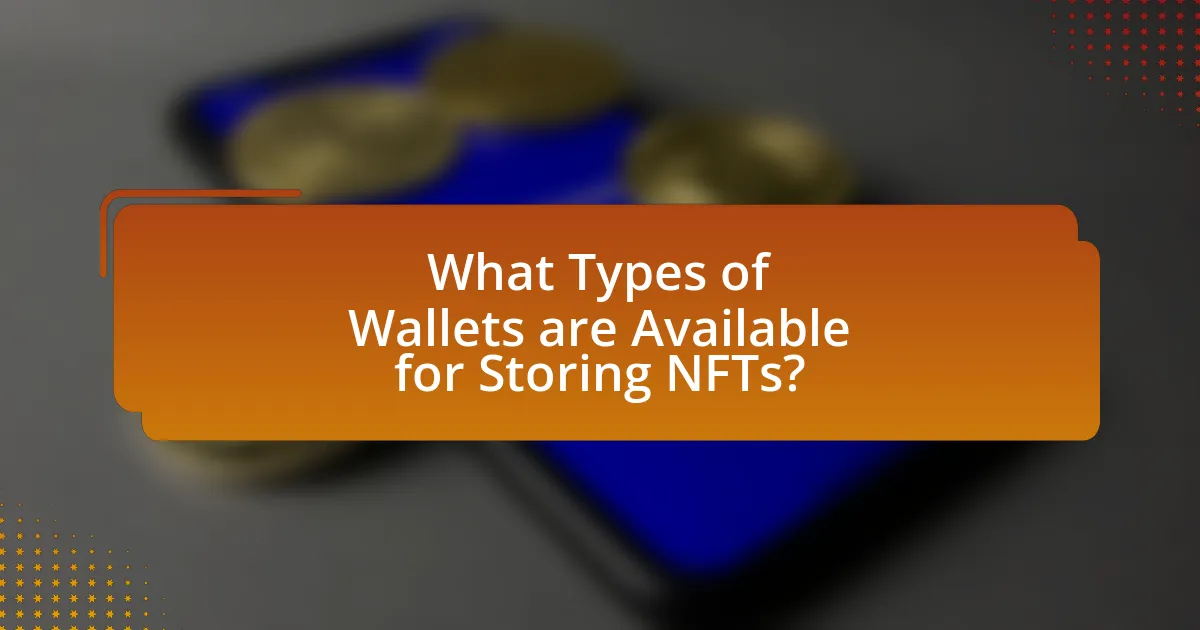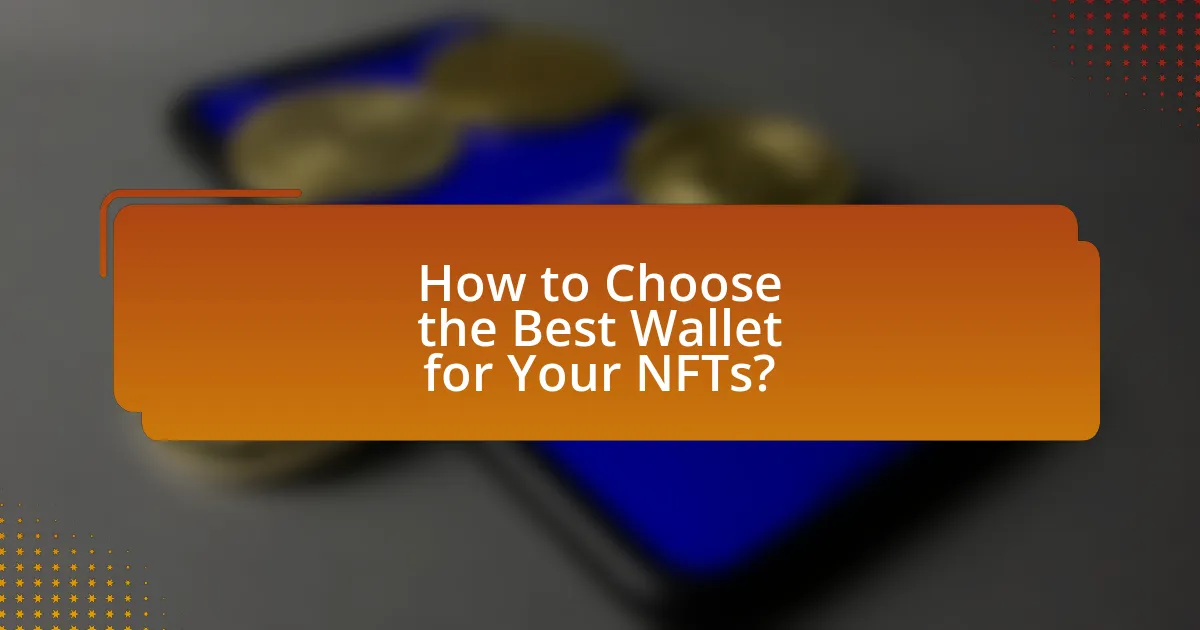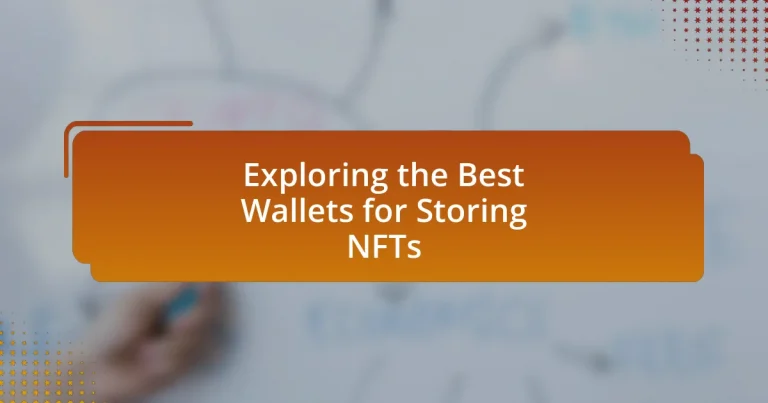The article focuses on NFTs (Non-Fungible Tokens) and the essential role of wallets in their storage and management. It explains the unique characteristics of NFTs compared to traditional digital assets, emphasizing the importance of ownership verification and security. The article categorizes different types of wallets—hot, cold, custodial, and non-custodial—while discussing their features, risks, and suitability for NFT collectors. Additionally, it provides guidance on selecting the best wallet based on security, compatibility, and user experience, along with best practices for managing NFTs effectively.

What are NFTs and Why Do They Need Wallets?
NFTs, or Non-Fungible Tokens, are unique digital assets that represent ownership of a specific item or piece of content on a blockchain, primarily Ethereum. They need wallets because these wallets securely store the private keys required to access and manage the NFTs, ensuring that ownership and transactions are protected from unauthorized access. The necessity of wallets is underscored by the fact that without them, users cannot interact with the blockchain to buy, sell, or transfer their NFTs, making wallets essential for the functionality and security of NFT ownership.
How do NFTs differ from traditional digital assets?
NFTs differ from traditional digital assets primarily in their uniqueness and ownership verification. Traditional digital assets, such as images or music files, can be easily copied and shared without loss of quality, leading to a lack of scarcity. In contrast, NFTs (Non-Fungible Tokens) are built on blockchain technology, which ensures that each token is unique and cannot be replicated. This uniqueness is verified through smart contracts, providing proof of ownership and provenance. For example, a digital artwork sold as an NFT can be traced back to its original creator, establishing its authenticity and value in a way that traditional digital assets cannot achieve.
What unique characteristics define NFTs?
NFTs, or Non-Fungible Tokens, are defined by their uniqueness, indivisibility, and ownership verification on a blockchain. Each NFT has distinct metadata and attributes that differentiate it from other tokens, making it one-of-a-kind. Unlike cryptocurrencies such as Bitcoin, which are fungible and can be exchanged on a one-to-one basis, NFTs cannot be exchanged on a like-for-like basis due to their unique properties. Additionally, NFTs are secured by blockchain technology, which provides a transparent and immutable record of ownership, ensuring that the provenance and authenticity of each token can be verified. This combination of uniqueness, indivisibility, and blockchain verification establishes NFTs as distinct digital assets in the realm of digital ownership.
Why is ownership verification important for NFTs?
Ownership verification is crucial for NFTs because it establishes the authenticity and provenance of digital assets. This verification process ensures that the holder of an NFT is the legitimate owner, preventing fraud and unauthorized duplication. According to a report by NonFungible.com, the NFT market reached a valuation of over $10 billion in 2021, highlighting the importance of trust in ownership to maintain market integrity. Without ownership verification, the value of NFTs could be undermined, leading to a lack of confidence among buyers and sellers in the marketplace.
What role do wallets play in NFT storage?
Wallets serve as the primary storage solution for NFTs, enabling users to securely hold, manage, and transfer their digital assets. These wallets store the private keys associated with NFTs on a blockchain, ensuring that ownership and transaction history are verifiable and tamper-proof. For instance, Ethereum-based wallets like MetaMask and hardware wallets such as Ledger provide users with the necessary security features to protect their NFTs from unauthorized access and theft.
How do wallets secure NFT ownership?
Wallets secure NFT ownership by storing the private keys associated with the NFTs on the blockchain. These private keys are essential for proving ownership and facilitating transactions. When a user wants to access or transfer their NFTs, the wallet uses these keys to authenticate the user’s identity and authorize the transaction. The security of NFT ownership is further enhanced by the use of cryptographic techniques, which ensure that only the wallet holder can access their NFTs. Additionally, many wallets offer features such as two-factor authentication and recovery phrases, providing further layers of security against unauthorized access.
What are the risks of not using a wallet for NFTs?
Not using a wallet for NFTs exposes individuals to significant risks, including loss of ownership, vulnerability to hacks, and lack of control over assets. Without a wallet, NFTs are often stored on centralized platforms, which can be susceptible to breaches; for instance, in 2021, the NFT marketplace Nifty Gateway experienced a hack that resulted in the loss of user assets. Additionally, without a wallet, users cannot easily transfer or sell their NFTs, limiting their ability to engage in the market effectively. Furthermore, centralized storage means that users rely on the platform’s security measures, which may not be robust, increasing the risk of losing access to their digital assets permanently.

What Types of Wallets are Available for Storing NFTs?
There are three main types of wallets available for storing NFTs: hot wallets, cold wallets, and hardware wallets. Hot wallets, which are connected to the internet, provide easy access and convenience for trading NFTs but are more vulnerable to hacks. Cold wallets, or offline wallets, offer enhanced security by storing NFTs offline, making them less susceptible to online threats. Hardware wallets, a subset of cold wallets, are physical devices that securely store private keys and are considered one of the safest options for NFT storage due to their robust security features.
What are the main categories of NFT wallets?
The main categories of NFT wallets are custodial wallets, non-custodial wallets, and hardware wallets. Custodial wallets are managed by third-party services that hold users’ private keys, making them user-friendly but less secure. Non-custodial wallets allow users to control their private keys, providing greater security and ownership of NFTs. Hardware wallets are physical devices that store private keys offline, offering enhanced security against online threats. Each category serves different user needs, balancing convenience and security in managing NFTs.
What are the differences between hot wallets and cold wallets?
Hot wallets are online wallets that are connected to the internet, allowing for quick and easy access to cryptocurrencies, while cold wallets are offline storage solutions that provide enhanced security by keeping private keys disconnected from the internet. Hot wallets facilitate immediate transactions and are user-friendly, making them suitable for frequent trading, but they are more vulnerable to hacking and cyber threats. In contrast, cold wallets, such as hardware wallets or paper wallets, offer a higher level of security against unauthorized access, making them ideal for long-term storage of NFTs and cryptocurrencies. The distinction lies in their connectivity and security features, with hot wallets prioritizing convenience and cold wallets emphasizing safety.
How do custodial wallets compare to non-custodial wallets?
Custodial wallets manage users’ private keys on their behalf, while non-custodial wallets allow users to retain full control over their private keys. This fundamental difference means custodial wallets often provide ease of use and recovery options, making them suitable for beginners, but they introduce risks related to trust and security since users must rely on the service provider. In contrast, non-custodial wallets enhance security and privacy by enabling users to manage their own keys, but they require a greater understanding of wallet management and carry the risk of losing access if keys are misplaced. According to a 2021 report by Chainalysis, custodial wallets accounted for approximately 70% of all cryptocurrency transactions, highlighting their popularity despite the inherent risks.
Which wallets are most popular among NFT collectors?
The most popular wallets among NFT collectors are MetaMask, Trust Wallet, and Coinbase Wallet. MetaMask is widely used due to its compatibility with Ethereum-based NFTs and decentralized applications, boasting over 10 million users as of 2021. Trust Wallet, the official wallet of Binance, supports a variety of cryptocurrencies and NFTs, making it a favorite for mobile users. Coinbase Wallet, linked to the Coinbase exchange, offers a user-friendly interface and secure storage for NFTs, appealing to both beginners and experienced collectors. These wallets are favored for their security features, ease of use, and integration with various NFT marketplaces.
What features make a wallet suitable for NFT storage?
A wallet suitable for NFT storage must have strong security features, user-friendly interfaces, and compatibility with various blockchain networks. Security features include private key management, two-factor authentication, and encryption to protect digital assets from unauthorized access. User-friendly interfaces ensure that both novice and experienced users can easily navigate the wallet and manage their NFTs. Compatibility with multiple blockchain networks, such as Ethereum and Binance Smart Chain, allows users to store a diverse range of NFTs without needing multiple wallets. These features collectively enhance the wallet’s functionality and reliability for NFT storage.
How do user reviews influence wallet selection?
User reviews significantly influence wallet selection by providing insights into the experiences of other users, which can guide potential buyers in making informed decisions. Positive reviews often highlight features such as security, ease of use, and customer support, while negative reviews can reveal potential issues or limitations of a wallet. Research indicates that 79% of consumers trust online reviews as much as personal recommendations, underscoring their impact on purchasing behavior. Consequently, users are more likely to choose wallets with higher ratings and favorable feedback, as these reviews serve as a form of social proof that can validate the reliability and functionality of the wallet for storing NFTs.

How to Choose the Best Wallet for Your NFTs?
To choose the best wallet for your NFTs, prioritize security, compatibility, and user experience. Security is crucial; opt for wallets that offer features like two-factor authentication and private key control. Compatibility with various NFT marketplaces and blockchain networks ensures you can manage your assets effectively. User experience matters as well; select a wallet with an intuitive interface that simplifies transactions. According to a report by NonFungible.com, wallets like MetaMask and Ledger are highly regarded for their security and functionality, making them popular choices among NFT collectors.
What factors should you consider when selecting an NFT wallet?
When selecting an NFT wallet, consider security, compatibility, user experience, and fees. Security is paramount; choose wallets that offer features like two-factor authentication and private key control to protect your assets. Compatibility with various blockchains is essential, as NFTs can exist on different networks like Ethereum or Solana. A user-friendly interface enhances the experience, making it easier to manage and trade NFTs. Lastly, be aware of transaction fees associated with the wallet, as these can impact the overall cost of buying, selling, or transferring NFTs.
How important is wallet security for NFT storage?
Wallet security is crucial for NFT storage because it protects digital assets from theft and unauthorized access. The decentralized nature of NFTs means that once they are transferred, they cannot be recovered without proper security measures in place. According to a report by Chainalysis, over $7.7 billion worth of cryptocurrency was stolen in 2021, highlighting the risks associated with inadequate wallet security. Secure wallets, such as hardware wallets, provide enhanced protection through offline storage and encryption, significantly reducing the likelihood of hacks and losses. Therefore, prioritizing wallet security is essential for safeguarding NFTs.
What user interface features enhance wallet usability?
User interface features that enhance wallet usability include intuitive navigation, clear labeling, and responsive design. Intuitive navigation allows users to easily find functions such as sending, receiving, and managing assets, which is crucial for efficient wallet operation. Clear labeling of buttons and sections reduces confusion, enabling users to understand their options quickly. Responsive design ensures that the wallet interface adapts seamlessly to different devices and screen sizes, improving accessibility. Research indicates that user-friendly interfaces can significantly increase user satisfaction and engagement, as seen in studies on digital wallet adoption rates.
What are the best practices for managing NFTs in a wallet?
The best practices for managing NFTs in a wallet include using a secure wallet, enabling two-factor authentication, regularly updating wallet software, and keeping private keys confidential. A secure wallet, such as a hardware wallet, protects NFTs from online threats, while two-factor authentication adds an extra layer of security. Regular software updates ensure that the wallet has the latest security features, and keeping private keys confidential prevents unauthorized access. According to a report by Chainalysis, 72% of NFT thefts occur due to compromised private keys, highlighting the importance of these practices in safeguarding digital assets.
How can you ensure the safety of your NFT assets?
To ensure the safety of your NFT assets, utilize secure wallets specifically designed for storing NFTs, such as hardware wallets or reputable software wallets with strong encryption. Hardware wallets, like Ledger or Trezor, store private keys offline, significantly reducing the risk of hacking. According to a report by Chainalysis, over $2.8 billion in cryptocurrency was stolen in 2021, highlighting the importance of secure storage solutions. Additionally, always enable two-factor authentication and regularly update wallet software to protect against vulnerabilities.
What common mistakes should be avoided when using NFT wallets?
Common mistakes to avoid when using NFT wallets include neglecting to secure private keys, using weak passwords, and failing to enable two-factor authentication. Securing private keys is crucial because losing them can result in permanent loss of access to NFTs. Weak passwords make wallets vulnerable to hacking, while two-factor authentication adds an essential layer of security. According to a report by Chainalysis, 72% of hacks in the crypto space are due to poor security practices, highlighting the importance of these precautions.
What are some tips for effectively using NFT wallets?
To effectively use NFT wallets, prioritize security by enabling two-factor authentication and using hardware wallets for storing valuable assets. Security measures protect against unauthorized access and potential loss of NFTs. Additionally, regularly update wallet software to safeguard against vulnerabilities, as outdated software can expose users to risks. Organizing NFTs within the wallet using labels or categories enhances management and retrieval efficiency, making it easier to track assets. Lastly, familiarize yourself with the wallet’s features and functionalities to maximize its potential, as understanding the tools available can improve the overall user experience.


